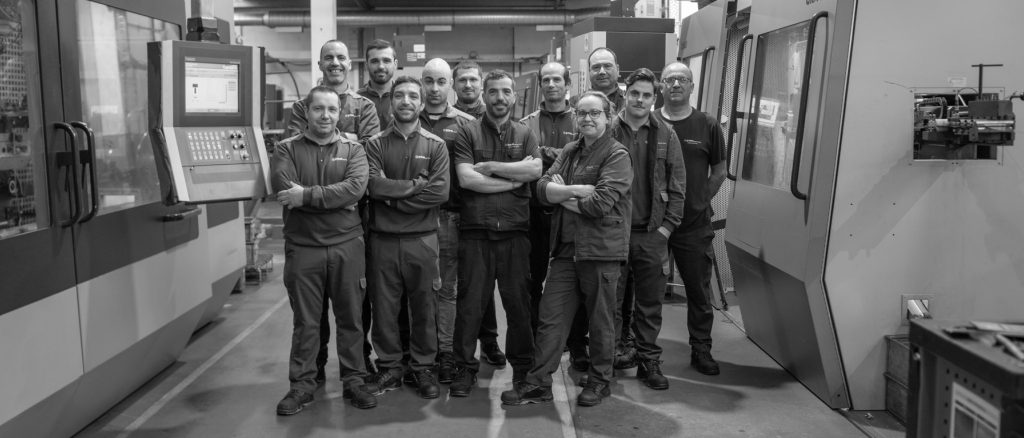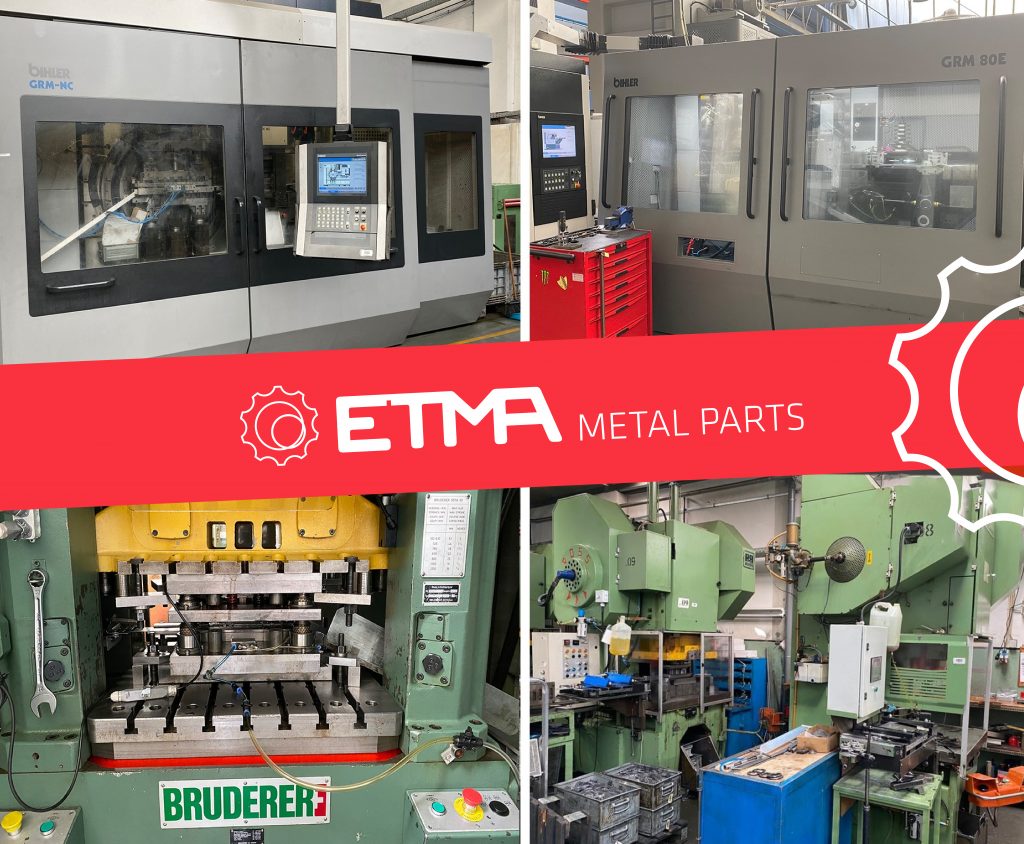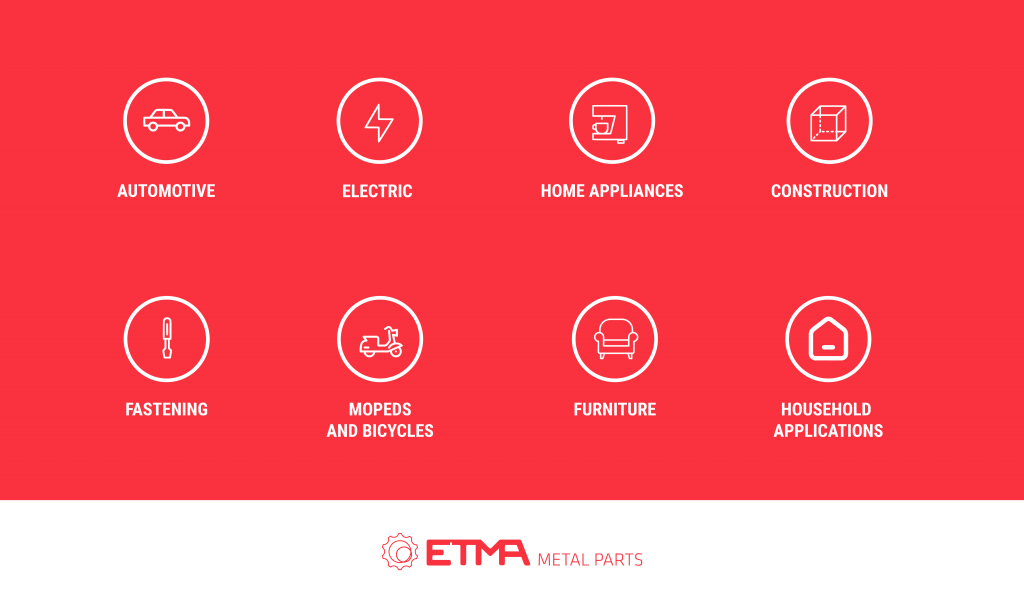
In order to meet the project requirements of its clients, ETMA has created an exclusive system that customises the offer of its services. This system is the 10 Integrated Production Processes, which includes the Stamping and Automatic Forming process.
In this article, we will describe the different details regarding these processes, as well as how ETMA works together with its clients to develop a set of customised solutions in order to reach the best solution for each request.
WHAT IS THIS PROCESS?
Stamping and Automatic Forming is a mechanical forming process, usually cold, that includes a set of operations, in which a metal strip or sheet is submitted to transformations aimed at obtaining new flat or hollow geometric shapes.
These operations may include:
- Metal strip or sheet cutting – obtaining geometrical shapes with a press and a matrix. The press applies pressure to the metal supported by the matrix. When the punch penetrates the matrix, it converts the pressure into shearing in order to cut the part, giving it the desired shape.
- Folding – its purpose is to obtain a part with one or more folds on a flat metal sheet. In this operation, the elasticity and the resistance of the material are key to the result of the process.
- Deep drawing or thermoforming – the purpose of this operation is to transform flat parts into hollow objects (in the shape of containers, such as tubes, for example), which are obtained through the deformation of the metal sheet using press strokes.
At ETMA, this process is usually carried out during the manufacture of stamped sheet metal parts up to 3 mm thick and 400 mm wide, such as: circuits, connectors, bushes, springs, clips, terminals, contacts, compression limiters, spacers, eyelets, sinks, among others.
WHAT ARE THE ADVANTAGES?
With the help of metal strip or sheet stamping, it is possible to manufacture parts made of low-carbon steel, stainless steel, aluminium, copper and different non-ferrous alloys. Therefore, and due to its characteristics, this production process is very adequate, especially for large series of parts, bringing great advantages, including:
- Large production, allowing for serial production, which reduces the general operation costs;
- The parts present the same finish, maintain the primitive characteristics of the material, such as high durability and mechanical resistance, and may not require further processing;
- Repeatability is another distinctive feature of this process, which ensures production consistency and facilitates the task of finding potential deviations;
- It allows high-quality control and the best possible use of the material, in a relatively short time when compared to other similar processes.
This way, Stamping and Automatic Forming is presented as a highly versatile and competitive process. This case-study is a very good example of it, in which versatility and support production processes available at ETMA are in evidence.
THE RIGHT PROCEDURE FOR PROPER EXECUTION
For proper execution of the Stamping and Automatic Forming process, ETMA follows a procedure with the following steps:
- Analysis of the client’s final drawing, to check sizes, dimensional tolerances, among others, in order to verify the feasibility of the project and, when necessary, suggest production alternatives;
- Quotation for the means of construction (tool) and the production process (part);
- Definition of an operational plan, describing all of the process steps, from tool creation, sample sending and corresponding client approval, to the conclusion of all the manufacturing processes used to create the part.
ETMA’S TEAM
The demand for tailored solutions, that comply with the requirements of each client, involves the development (comprised of engineers and specialised technicians) and sales teams, who share knowledge and experience with the client, resulting in synergies that are mutually beneficial.
A highlight goes to the Stamping and Automatic Forming team, who plays a key role with ETMA’s clients, providing guidance regarding the best production and development plans for the requested parts, as well as their improvement.
EQUIPMENT
The production capacity of ETMA is ensured by the diversity and experience of over 80 years in stamping processes, with the use of progressive tools, semi-deep stamping, Bihler forming machines and precision quick presses.
The production equipment linked to this process includes:
- Eccentric presses from 12 to 250 T and Bruderer quick presses: Helmerding TPH12, Ross 40T, Ross 80T, Press Ross 50T, Press Ross 63T, Press Ross 105T, Yangli JMD31-250, Bruderer BSTA 50 and Legnani DMC T80, Yangli;
- Automatic forming machines: Bihler GRM NC, GRM-80 E, RM 40K, RM-25, RM-30, RM-35, GRM-50 and Franconi B20.
MAIN BUSINESS AREAS
ETMA Stamping and Automatic Forming is a highly requested process by different business areas, including:
The Stamping and Automatic Forming process is, therefore, a very useful process in all of ETMA’s 10 Production Processes, showcasing its ability to develop and produce a project from start to finish within our own facilities, which results in a more beneficial solution for the client.
Click here to discover more about the ETMA Stamping and Automatic Forming process or download our brochure.
If you are interested in learning more and, eventually, talking to us about a project, please do not hesitate to contact us.





